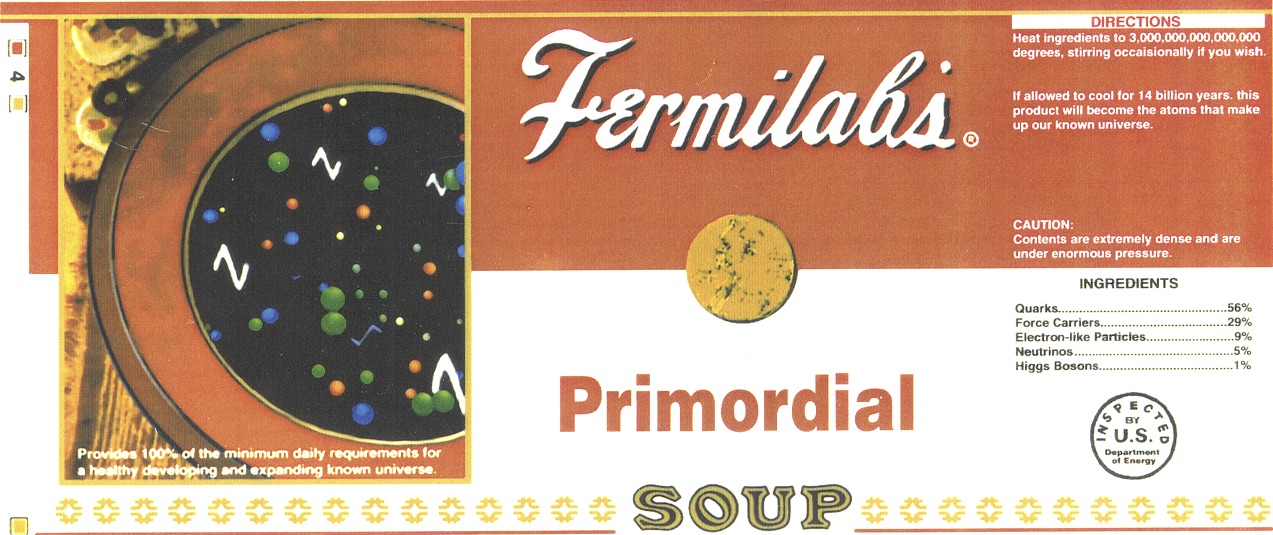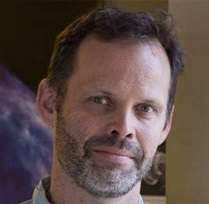1.18: The Early Universe
( \newcommand{\kernel}{\mathrm{null}\,}\)
 |
|
The hot big bang contained a hot, dense "soup" of elementary particles. Fermilab is a U.S. national laboratory in Illinois that is the home of the Tevatron, a particle accelerator that smashed protons into anti-protons at high energies to create new particles. |
In the next chapters we study the "primordial soup" of the big bang. One of the first human beings to travel this intellectual territory was George Gamow born in 1904 in Russia as Georgi Antonovich Gamow. While at university of Leningrad, he studied under Friedmann (of Friedmann-Robertson-Walker fame) until Friedmann suddenly died in 1925, forcing Gamow to change dissertation advisers. Gamow's early accomplishments include in 1928 solving the problem of alpha decay of nuclei through quantum tunneling, for which the Gamow Factor (a probability factor involved in tunneling through the Coulomb barrier) bears his name. As the Soviet Union grew more oppressive, Gamow sought to escape to Europe but was denied permission to leave. Eventually Gamow and his wife managed to flee to the United States where he became a professor at George Washington University in 1934.
At GWU, Gamow turned his interest toward astrophysics and fathered the idea of the hot Big Bang. His main assumption was that the universe started at near-infinite temperature and density from which it rapidly expanded and cooled. In this early stage, the universe would consist of protons, neutrons, and electrons zipping around in a hot bath of electromagnetic radiation. He argued that one could build all the elements from the ground up via neutron capture, but in the end was never able to account for the abundances of elements higher than helium. Gamow joked that his theory was basically correct, since it accounted for 99% of the universe's rest mass in hydrogen and helium. Gamow published the paper, titled ``The Origin of Chemical Elements'' with his PhD student Ralph Alpher in the April 1948 issue of Physical Review. Gamow included famous contemporary astrophysicist Hans Bethe in the author list (without his notification, nevermind permission!) so that it would read like α, β, γ.
Alpher and Gamow found that the big bang had to be hot in order to avoid over production of the elements. A cold big bang would expand more slowly, allowing more time for build-up of heavy elements via neutron capture. Alpher and another researcher, Robert Herman, predicted that this heat should still be present today, in the form of black-body radiation cooled down by the expansion from billions of degrees to just about 5∘ Kelvin. This prediction was eventually verified with an accidental discovery in 1964 by Bell Labs astronomers Arno Penzias and Robert Wilson of an isotropic background with a temperature of about 3∘ K, a discovery that led to the establishment of the hot big bang as the dominant cosmological paradigm, as well as the 1979 Nobel Prize in physics for Penzias and Wilson.
It is now quite well-established that the universe used to be very hot, very dense, and expanding very rapidly. Relics that remain today from that era include most of the Hydrogen and Helium in the universe, trace amounts of Deuterium, Helium-3, and the photons that comprise the cosmic microwave background discovered by Penzias and Wilson. There is indirect evidence, via multiple channels, that there is also a cosmic neutrino background today, left over from the big bang. More speculatively, the dark matter is another relic of the big bang.
To understand this primordial soup and its relics, we now turn our attention from a relativistic understanding of the expansion of space, to statistical mechanics. We begin with equilibrium statistical mechanics, before moving on to a discussion of departures from equilibrium. We will come to understand the production in the big bang of Helium, photons, other "hot" relics such as neutrinos, and "cold" relics such as the dark matter. We will also discuss the observations that test our ideas and constrain parameters of the standard cosmological model and its extensions.


